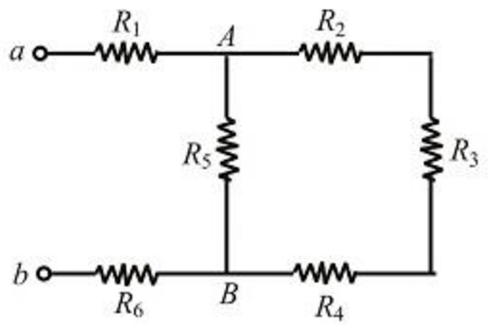Question
In: Physics
What is the equivalent resistance between points a and b of the six resistors shown in the Figure ?
What is the equivalent resistance between points a and b of the six resistors shown in the Figure below?

Solutions
Expert Solution
Draw the labeled circuit as shown below.

Write the expression for the three resistors connected in series.
$$ R_{e q}=R_{2}+R_{3}+R_{4} $$
Here, \(R_{e q}\) is the equivalent resistance, and \(R_{2}, R_{3}, R_{4}\) are the three resistors connected in series.
Write the expression for the equivalent resistance across branch \(\mathrm{AB}\).
$$ R_{A B}=\frac{R_{5} \times R_{e q}}{R_{5}+R_{e q}} $$
Here, \(R_{A B}\) is the equivalent resistance across branch \(\mathrm{AB}\) and \(R_{5}, R_{e q}\) are the two resistors connected in parallel across points \(\mathrm{AB}\).
Write the expression for the equivalent resistance of the circuit.
$$ R_{e q}^{\prime}=R_{A B}+R_{1}+R_{6} $$
Here, \(R_{e q}^{\prime}\) is the equivalent resistance of the circuit and \(R_{A B}, R_{1}, R_{6}\) are the three resistors connected in series.
Conclusion:
Substitute \(2.20 \Omega\) for \(R_{2}, 2.00 \Omega\) for \(R_{3}, 4.40 \Omega\) for \(R_{4}\) in the equation (I).
$$ \begin{gathered} R_{e q}=(2.20 \Omega)+(2.00 \Omega)+(4.40 \Omega) \\ =8.60 \Omega \end{gathered} $$
Substitute \(8.60 \Omega\) for \(R_{e q}\) and \(5.10 \Omega\) for \(R_{5}\) in the equation (II).
$$ \begin{aligned} R_{A B} &=\frac{(5.10 \Omega) \times(8.60 \Omega)}{(5.10 \Omega)+(8.60 \Omega)} \\ &=\frac{43.86}{13.7} \Omega \\ &=3.20 \Omega \end{aligned} $$
Substitute \(3.70 \Omega\) for \(R_{1}, 3.20 \Omega\) for \(R_{A B}, 6.20 \Omega\) for \(R_{6}\) in the equation (III).
$$ \begin{gathered} R_{e q}^{\prime}=(3.20 \Omega)+(3.70 \Omega)+(6.20 \Omega) \\ =13.1 \Omega \end{gathered} $$
Thus, the equivalent resistance of the circuit is \(13.1 \Omega\).
The equivalent resistance of the circuit is 13.1Ω.
Related Solutions
For the combination of resistors shown, find the equivalent resistance between points A and B.
What is the equivalent resistance for the circuit shown in the figure? (Figure 1) For the...
You have three 1.3 kΩ resistors. A.) What is the value of the equivalent resistance for...
The circuit shown in (Figure 1) contains two batteries, each with an emf and an internal resistance, and two resistors.
Three resistors connected in parallel have an equivalent resistance of 1Ω
Four resistors are connected to a battery as shown in the figure. The current in the...
Find the current through each of the three resistors of the circuit shown in the figure (Figure 1).
When resistors 1 and 2 are connected in series, the equivalent resistance is 14.4 Ω. When...
When resistors 1 and 2 are connected in series, the equivalent resistance is 22.2 Ω. When...
Two points A and B on the surface of the Earth are at the same longitude and θ = 55.0° apart in latitude as shown in the figure below.
- Calculate the pH of a buffer solution prepared by dissolving 4.2 g of NaHCO3 and 5.3...
- Assume you are considering a portfolio containing two assets, L and M. Asset L will represent...
- Consider an object with a mass of 3.5 kg located at R1 = (0.0 m, 2.5...
- Block 1, with mass m1 and speed 3.5 m/s, slides along an x axis on a...
- Deriving cash flows for asset disposition. Custom Machining Company (CMC) purchased a made-to-order machine tool for...
- A steam pipe is covered with 1.50-cm thick insulating material of thermal conductivity of 0.200 cal/cm...
- Suppose a bridge has 10 toll booths in the east-bound lane: four are only for E-Z...
 DogeShow answered 4 years ago
DogeShow answered 4 years ago